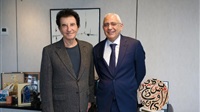Sayyid Qutb’s ideas and their impact on contemporary terrorist movements

Sayyid Qutb is considered the founder of the discourse of
violence and blood in the modern era. He established a current within the
Brotherhood more violent than the mother group. This stream was later called
the Qutbis or Tanzim 65 (Organization 65). Regarding the impact of Qutb’s ideas
on contemporary terrorist movements, Mustafa Zahran, an Egyptian researcher
specializing in Islamist movements, believes that the wide spread of Qutb’s
intellectual propositions continues to be a major problem for the contemporary
Islamic situation.
Qutb has been widely criticized as being responsible for the
transformations in the Islamist experiment in the last decades of the twentieth
century, especially after jihadist groups sought to extract Qutb’s ideas from
the theoretical realm to a practical reality, manifesting first in its
formative phases with al-Qaeda and ending with the current radical version as
represented by ISIS, with the accompanying transition from jihadist groups to
claiming statehood.
In his investigative book "References of the Terrorist
Mind: Sources and Ideas", Zahran looks at some of the theoretical sources
on which salafists, extremist jihadists and terrorist organizations base the supposed
legitimacy of their violence against society and the state. The book follows
the historical path of jihadist ideologies as they mature at the level of theory,
formation and influence, given that the general understanding that attempts to
explain the phenomenon of “Islamic violence” must evoke the traditional and
modern ideological symbols and frameworks to define the theoretical templates
that the salafi jihadist discourse promotes.
Zahran examines this problem, the size of the intellectual
intersection that has emerged during the transformations of the jihadist
current, and its stability from the local to the regional framework, especially
as it became globalized. He then goes on to show the size of interaction and
the degrees of influence and impact. The work concludes by presenting the most
important intellectual and practical stations for the course of that
interaction and what various jihadist leaders have stated, on the extent of the
relationships and degree of harmony shown by these currents and employing Qutb’s
ideas in the framework of the “jihadist project”, allowing them to legitimize their
tools to confront the world around them, especially the West and the United
States.
The controversial terminology like jahiliyya (ignorance) and
the call for governance and separating between the people of truth and
falsehood, which were espoused in Qutb’s books and articles, found their place
and misfortune among the jihadists, serving as compelling evidence for some of
the connection between Qutb and those currents, which reinforced the
radicalization of their mechanisms to counter their opponents and subject them
to permanent condemnation and accusation, which the book seeks to diagnose
under the microscope.
Zahran reaches the conclusion that Qutb moved from the far
left to the far right on a journey of ever stricter ideas, especially since different
contexts and successive circumstances contributed to the progression of his
theories, which led some to later take his written ideas and theories and make
them a practical reality employed by extremists. This is a problem that still needs
solutions to this day, ever since Qutb’s death.
The articulated dimension of Qutb’s ideas lied in modifying,
qualifying and ripening the ideas of Abu al-Ala al-Mawdudi, as he contributed
to molding ideas that were not his in a deeper and more extended way. Qutb went
from a naughty student of Mawdudi’s to becoming the “godfather” to those who
came after him and transformed these ideas into a reality on the ground.









